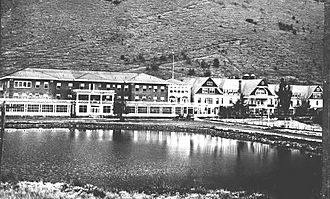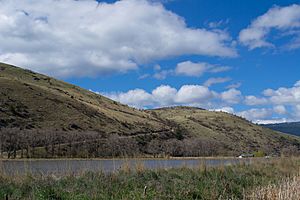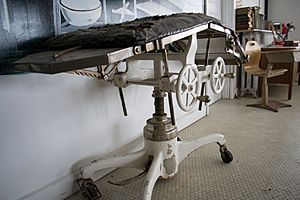Hot Lake Hotel facts for kids
Quick facts for kids Hot Lake Hotel |
|
|---|---|

Hot Lake Hotel and Sanitarium, circa 1920s; the wooden gabled structure on the right side would later burn down in a 1934 fire.
|
|
| General information | |
| Architectural style | Colonial Revival Shingle Style |
| Location | Hot Lake, Oregon, U.S. |
| Coordinates | 45°14′36″N 117°57′24″W / 45.24333°N 117.95667°W |
| Design and construction | |
| Architect | John Virginius Bennes |
|
Hot Lake Resort
|
|
| Lua error in Module:Location_map at line 420: attempt to index field 'wikibase' (a nil value). | |
| Built | 1864 (first incarnation) 1907 (final construction) |
| Restored | 2003–2010 |
| NRHP reference No. | 79002148 |
| Added to NRHP | March 15, 1979 |
The Hot Lake Hotel is a super old and famous building in Hot Lake, Oregon. It's also known as the Hot Lake Sanatorium or Hot Lake Resort. This amazing place was first built way back in 1864.
The hotel got its name from a special thermal spring right on its property. For many years, it was a fancy resort and a health center. People came from all over the world because they believed the mineral water had healing powers. Guess what? It was also the first commercial building ever to use geothermal energy (heat from the Earth) to warm itself!
After a big fire in 1934, part of the hotel was destroyed. The remaining building was used for different things, like a retirement home and a school for nurses during World War II. The hotel was empty for a while, but it was added to the National Register of Historic Places in 1979 because it's so important.
Today, the Hot Lake Hotel is a busy hot springs resort again! You can stay there, eat at the pub, watch movies in its theater, and soak in the warm springs. People have been working hard since 2003 to fix it up and make it beautiful once more.
Contents
Discovering Hot Lake's Natural Wonders
The amazing hot springs at Hot Lake are located at the bottom of a big hill. Long ago, Native Americans used these springs. The Nez Perce people called the lake "Ea-Kesh-Pa."
Historians think Hot Lake was one of the first hot springs that European settlers ever visited. An explorer named Robert Stuart wrote about the springs in 1812. He described a large pool of water fed by a sulphur spring that was boiling in one corner. He also mentioned that many elk visited the area.
After the Oregon Trail brought more settlers, the land around the lake became a cattle ranch. A sailor named Tommy Atkins bought it. There's a story that Atkins got better from many sicknesses after falling into the spring! The lake's spring pumps out almost half a million gallons of water every day. The water is super hot, usually around 200°F (93°C).
A Look Back: Hot Lake Hotel's History
Building the First Hotel (1864–1906)
In 1864, a man named Samuel Fitzgerald Newhart came to the area. He built the first wooden building at Hot Lake. This building was like a small town all in one place! It had a post office, a blacksmith shop, a dance hall, a barber shop, and a bath house.
Later, in 1884, the Union Pacific Railroad built tracks nearby. In 1903, work started on a new hotel part and more bath houses. A doctor named Dr. Phy joined the project in 1904. They began building a brick structure to be used as a health center, called a sanatorium.
The Golden Years: A Busy Resort (1907–1933)
A famous architect named John Virginius Bennes designed the main hotel building. He also designed many buildings at Oregon State University. In 1906, the large brick part of the hotel was finished. It was huge, about 65,000 square feet! This building had a U-shape and a sunny room facing the hill.
The hotel was heated using the hot water from the geothermal springs. This made it the first known commercial building in the world to use geothermal heating!
When it was fully expanded, the hotel had 105 guest rooms and a 60-bed hospital ward. It also had a ballroom, a barber shop, a candy store, a drug store, a post office, a bank, and even its own train station. The resort had amazing soaking tubs with spring water. It even had an operating room with a special viewing deck for people to watch surgeries!
Locals called the hotel "The Town Under One Roof" because it had so much. It even grew its own vegetables and raised its own animals for food.
In 1917, Dr. W.T. Phy bought the hotel and renamed it "Hot Lake Sanitorium." It became known as both a fancy resort and a hospital. Doctors used the mineral waters to help treat patients. This made the resort a leader in new medical ideas in the western United States.
By 1924, the hotel was a very popular place. Famous doctors, like the Mayo brothers who started the Mayo Clinic, visited often. The hotel had many nurses, doctors, and other medical staff. It earned the nickname "The Mayo Clinic of the West."
Advertisements said the hot springs were the "largest, hottest, and most curative springs known." They also claimed that drinking the water and using mud baths could help with many health problems.
Fire and Changes (1934–1990)
Dr. Phy, the main owner, passed away in 1931. On May 7, 1934, a big fire destroyed most of the hotel's wooden parts. The large brick section, however, survived. Before the fire, the hotel had almost 300 rooms and could feed over 1,000 guests. After the fire, fewer people visited, and only the hospital area on the third floor kept running.
During World War II, a flight school and a nurse's training center opened at the hotel in 1939. Later, in 1951, the building became a nursing home for older people. It was a rest home until 1974. After that, a restaurant and nightclub tried to open but didn't last long.
In the mid-1980s, Dr. Lyle Griffith bought the property. He used a small part of the hotel as a bath house. But by 1991, the bath house closed, and the hotel was left empty. It started to fall apart because of vandals and the weather.
Left Alone (1991–2002)
The building stayed empty and broken for over fifteen years. All 250+ windows were smashed, and parts of the roof and floor were missing.
In 2001, the hotel was even shown on a TV show called The Scariest Places on Earth.
Bringing it Back to Life (2003–Present)
In 2003, David Manuel bought the hotel, which was in very bad shape. All 368 windows were broken, and most of the roof was gone. Restoration work started right away. After two years, in 2005, it opened for tours while rooms were still being fixed.
Even with problems, like a part of the west wing collapsing in 2008, the Manuel family kept working. By 2010, the building was a bed and breakfast. It had restored rooms, a spa, a restaurant, and a museum.
In 2019, the Lodge at Hot Lake Springs was ready with new features. These included a pub, better rooms, a hot springs soaking area, and a 60-seat movie theater. Two million gallons of mineral-rich hot spring water still flow from the Earth every day.
In April 2020, new owners took over. They made big improvements to the plumbing, electricity, and fire safety systems. The community has been very supportive, seeing it as a great place for tourists and good for the local economy. The movie theater is now open, and outdoor areas might host concerts.
Important historical parts like the Grand Entry Porch and the Historic Spring House have been carefully restored. The Lodge at Hot Lake Springs is open for overnight stays.
As of 2021, 15 renovated suites are available to rent. Guests can use the pools 24 hours a day. There are plans to add even more pools in the future.
The hotel is part of the Hot Lake Springs Resort, which was added to the National Register of Historic Places in 1979.
Hot Lake Hotel in Pop Culture
Besides being on The Scariest Places on Earth, the hotel was also used as a filming spot for a music video by the musician Laura Gibson.
See also
- National Register of Historic Places listings in Union County, Oregon
- Reportedly haunted locations in Oregon




